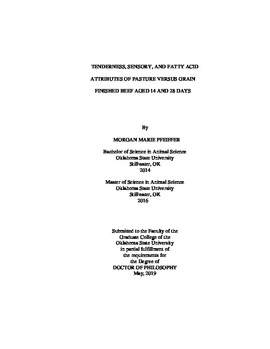| dc.description.abstract | The objective of this study was to evaluate the effects of two finishing systems, grain and pasture, and postmortem aging on the sensory, tenderness, display color, and fatty acid profiles of beef from their carcasses. All cattle (n = 473) were on a forage diet during the stocker period. They were randomly assigned to either a grain based or pasture-based finishing diet. Conventionally finished cattle were fed for 94 d, and pasture cattle were fed for either 88 or 130 d. Average age of cattle at slaughter was 18.2 mo for concentrate finished and 18.9 mo for alfalfa finished. Strip loins (n = 445) were cut into 2.54 cm thick steaks and vacuum packaged. Display color was evaluated from a sub-set of steaks during 1 year of the study (n = 60). The data were analyzed using the Mixed and Glimmax Procedures of SAS. No interaction for treatment x year was indicated, so data were analyzed by finishing system and aging time (if applicable). Carcasses from cattle finished on a grain diet were fatter (P < 0.05) than those finished on pasture. Also, no differences, (P > 0.05), was found for Warner-Bratzler shear force (WBS) or sensory tenderness. There was an interaction between finishing type and days aged (P < 0.05) for both initial and sustained juiciness. Panelists rated 14 d grain finished as the strongest (P < 0.05) for beefy/brothy flavor. Additionally, 28 d pasture and grain finished steaks were rated the strongest for grassy flavor (P < 0.05). There was a display day x packaging x finishing diet interaction (P < 0.05) for muscle color, surface discoloration, and muscle darkening. There was a significant difference showing grain finished beef had more fat (P < 0.05), but no difference (P > 0.05) for protein, moisture, and collagen. The fatty acid chemical analysis found a difference (P < 0.05) for PUFA n-3, CLA, and n-6:n-3. There was a numerical difference, but no statistical difference (P > 0.05) for MUFA with grain finished being higher. Finally, SFA, PUFA n-6, VA, and OT had no differences (P > 0.05) between finishing system. | |
